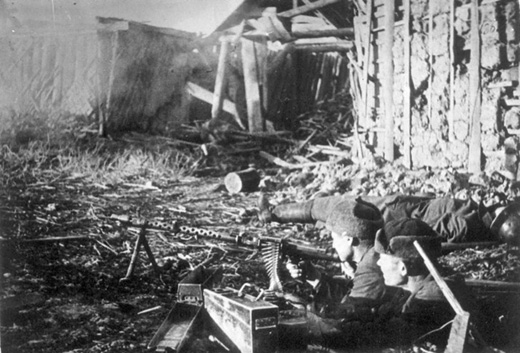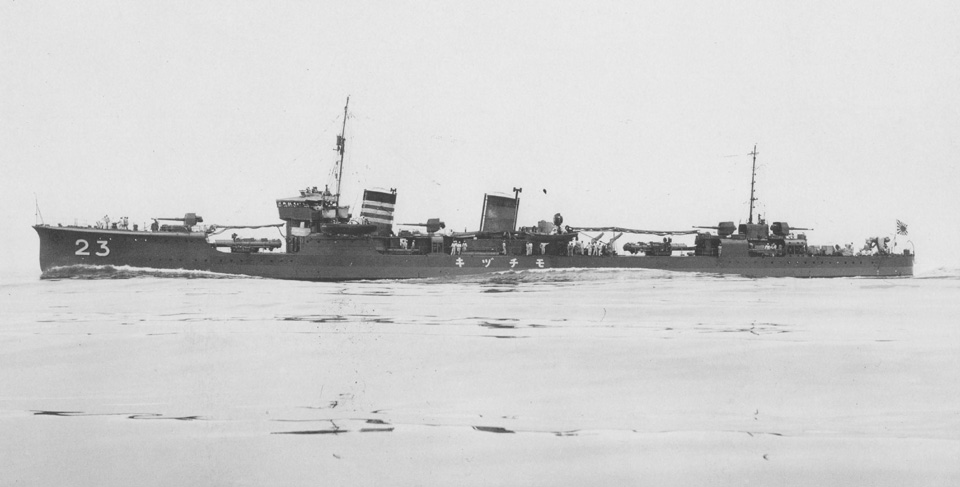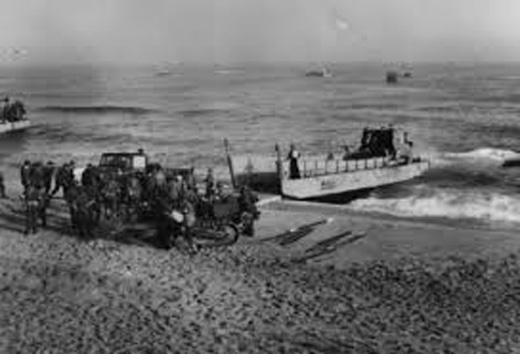Air Operations, Aleutians
- 2 28th Composite Bombardment Group B-26s and 4 XI Fighter Command P-38s attack but do not hit a cargo ship at Kiska.
- 1 B-17 and 4 P-38s attacking the airfield and base facilities on Attu claim the destruction of 8 moored A6M2-N 'Rufe' float fighters.
Air Operations, Bismarcks
38th Medium Bomb Group B-25s attack a ship near New Ireland.
[Air Operations, CBI
- B-24s of the 7th Heavy Bomb Group's 436th Heavy Bomb Squadron attack Rangoon, Burma.
- 23rd Fighter Group P-40s shoot down 3 A6M Zeros near Kweilin, China at 1245 hours.
Air Operations, Europe
BOMBER COMMAND
Daylight Ops:
- 12 Bostons raid Le Havre and score a hit on the large German merchant ship, the target of several recent raids, putting the ship out of action for several months. There are no losses.
- 213 aircraft are sent to Hamburg: 74 Wellingtons, 72 Lancasters, 48 Halifaxes and 19 Stirlings.
- The planes run into cloud, icing and winds which had not been forecast; no clear identification of Hamburg is made; 150 crews bomb; reports from the ground say thick cloud cover and heavy rains and that most of the bomb loads fall in the Elbe or in open country; 26 fires are started in Hamburg, 3 of which are large; 3 people are killed and 16 injured.
- 5 Lancasters, 4 Stirlings, 4 Wellingtons and 2 Halifaxes are lost.
- 15 Stirlings drop leaflets over France without loss.
Air Operations, New Guinea
- 22nd Medium Bomb Group B-26s attack Buna.
- 3rd Light Bomb Group A-20s attack Oivi in direct support of an Australian Army ground offensive in the Owen Stanley Mountains.
- 374th Troop Carrier Group transports airlift the leading elements of a fresh regiment of the US 32d Infantry Division to Abels Field, from which the ground troops will march to Pongani.
Battle of the Atlantic
Adm Sir Max Horton is appointed Commander-in-Chief, Western Approaches in the anti-U-boat war.
[Eastern Front
'Foreign Armies East Branch' of the German information service reports that Russian forces are concentrating in the Stalingrad area and opposite the 3rd Rumanian Army. The German services are not able at this stage to say whether these concentrations suggest a big general offensive or simply a local action.
Brothers Klimov with Captured German MG-34 |
 |
As feverish activity continues behind the Soviet lines, the Fremde Heer Ost department of the German High Command issues a statement which maintains that a limited offensive against Army Group Center is likely and, that while a build up of forces against the positions of the 3rd Rumanian Army is recognized but are noth thought to constiture a major threat. To stiffen the Rumanian defenses, the XLVIII Panzer Corps, with 1 German and 1 Rumanian armored division, is moved behind the Rumanian front.
Lead units of the 13th Panzer Division reaches the western outskirts of Ordzhonikidze. The 23rd Panzer Division is unable to provide support, being strung out along the flank of the 13th Panzer.
[Guadalcanal
Having contained the Japanese in the Koli Point area, the American force in the area can now reduced. The 164th's regimental headquarters, the Antitank Company, the 3rd Battalion, 164th Infantry, and B Company, 8th Marines, are brought back to the Lunga perimeter by boat and truck. At Koli Point, the 2nd Battalion, less E Company, 164th Infantry, takes positions on the right of the 1st Battalion, 7th Marines. E Company is committed to the left flank of the 2nd Battalion, 7th Marines, during the night. The Japanese attempt several times to break out of the trap using machine-gun, mortars and hand grenades, but to no avail. Supported by 155-mm batteries, 2 75-mm pack howitzer batteries and aircraft, the pocket begins to be reduced.
Resuming the Kokumbona offensive, under Col Arthur's command, the 1st Battalion, 164th Infantry, the newly arrived 8th Marines and the 2nd Marines, less the 3rd Battalion, move west from Point Cruz. With artillery support from 1st, 3rd and 5th Battalions of the 11th Marines, this force executes a frontal attack on an 3-battalion front. The 1st Battalion, 164th Infantry, advances on the right along the beach while the 2nd Battalion, 2nd Marines, in the center, and the 1st Battalion, 2nd Marines, is echeloned to the left and rear in the attack.
Carlson's column reaches Binu and receives new orders. Carlson is to remain at Binu but send scouts to determine size and composition of the Japanese unit.
Japanese Destroyer Mochizuki |
 |
Indian Ocean
The US freighter Marcus Whitman (7176t), sailing independently to Dutch Guiana from Cape Town, South Africa, is torpedoed by the Italian submarine Leonardo da Vinci and abandoned without loss. She is in turn sunk by gunfire from the submarine.
[Mediterranean
- The British corvette Gardenia sinks after colliding with the British naval trawler Fluellen off Oran with the loss of 3 crewmen.
- The British minesweeper Cromer sinks on a mine in the Eastern Mediterranean with the loss of 46 of her crew.
- The US transport Leedstown (AP-73), bombed and torpedoed by German planes, is torpedoed and sunk by U-173 near Algiers.
New Guinea
Advance elements of the 2nd Battalion, 126th Infantry, US 32nd Division, arrive at Natunga. The airlift of the 126th Infantry, less the 2nd Battalion, from Port Moresby to the forward area begins. The leading elements of the 1st Battalion, under Lt-Col Edmund J. Carrier, are flown to Abel's Field, since Pongani Field is temporarily unserviceable, and start toward Pongani on foot. The rest of the 1st Battalion (Companies C and D, less 2 platoons), under Maj Richard D. Boerem, is flown to Pongani and starts moving toward Natunga.
[North Africa
At Casablanca the US forces secure their beachheads and at Port Lyautey there is more heavy fighting between French tanks and Gen Truscott's troops. The US 3rd Div slows down its adavnce on Casablanca, waiting for heavy equipment and artillery which has still to be landes. The town of Oran still holds out, but Gen Anderson, who has landed to take command of 1st Army at Algiers, is able to send armored columns rushing to the east towards Tunis and Bizerta to prevent those two important centers from being captured by the Axis forces. Prime Minister Laval agrees to allow the Germans to use airfields in Tunisia, and the first German troops are flown in immediately. The British planners of TORCH, particularly Adm Cunningham, wished to make landings as far west as Bone and Bizerta, but this was vetoed by the American Chiefs of Staff. In retrospect this decision seems to have been an error.
Gen Giraud arrives in Algiers but Gen Clark realizes now that Darlan is likely to command more loyalty and, therefore, continues to press him to declare for the Allies. Publicly Pétain is strongly opposed to the Allied landings but secretly he is giving some encouragement to Darlan to negotiate with them.
Axis submarines, dive-bombers and torpedo planes attack the Allied convoys and sink an American transport off Algeria. They also damage the US battleship Massachusetts, 2 cruisers, 2 destroyers and some other ships.
As the bad weather improves the British 8th Army renews its pursuit of the enemy, whose resistance is broken by the New Zealand 2nd Div as it enters Sidi Barrani. Rommel commences a rapid retreat from Sidi Barrani to El Agheila.[MORE]
Americans Landing in Algeria |
 |